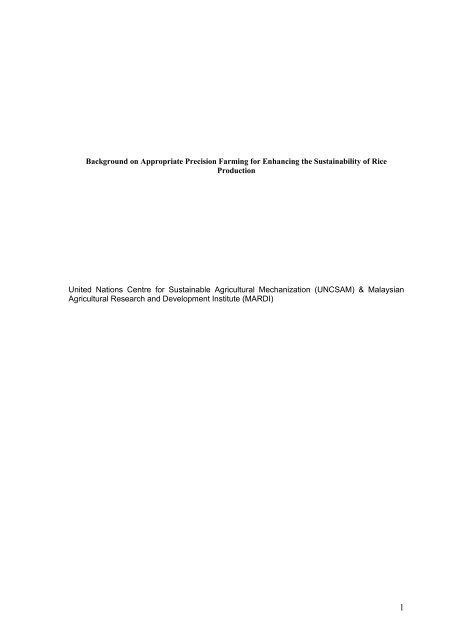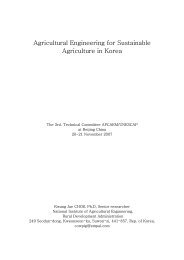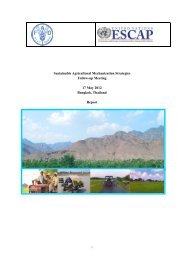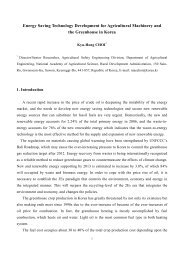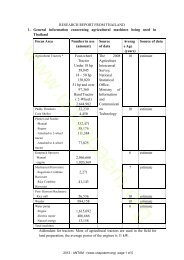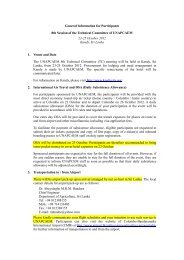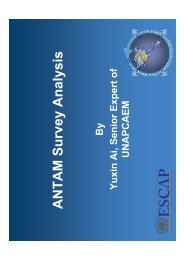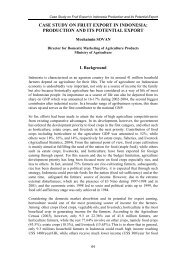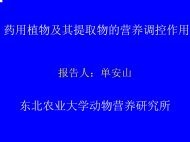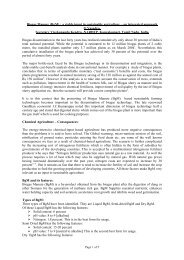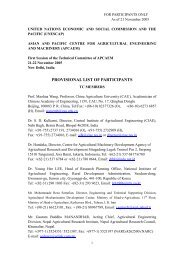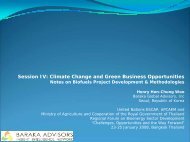Background on Appropriate Precision Farming for Enhancing the ...
Background on Appropriate Precision Farming for Enhancing the ...
Background on Appropriate Precision Farming for Enhancing the ...
You also want an ePaper? Increase the reach of your titles
YUMPU automatically turns print PDFs into web optimized ePapers that Google loves.
MESSAGE FROM Mr. Bing Zhao, Chief of <strong>the</strong> United Nati<strong>on</strong>s Centre <strong>for</strong> SustainableAgricultural Mechanizati<strong>on</strong> (UNCSAM)Rice is <strong>the</strong> major crop <strong>for</strong> milli<strong>on</strong>s living in <strong>the</strong> Asia-Pacific, and 90 per cent of <strong>the</strong> world'soutput of rice is produced and c<strong>on</strong>sumed within Asia. Milli<strong>on</strong>s grow <strong>the</strong>ir own rice and aredependent <strong>on</strong> sales of surplus rice to provide <strong>the</strong>m with cash to purchase o<strong>the</strong>r necessities.Although most Asian rice farms are small holders, <strong>the</strong>y employ intensive labor practices inplace of mechanizati<strong>on</strong>. With limited land, huge populati<strong>on</strong> and food insecurity exacerbated by<strong>the</strong> lingering effects of <strong>the</strong> global financial crisis and climate change, a viable opti<strong>on</strong> to createfood surpluses is by increasing land productivity via <strong>the</strong> introducti<strong>on</strong> of efficient and adaptableprecisi<strong>on</strong> farming technology <strong>for</strong> rice producti<strong>on</strong> farming systems in <strong>the</strong> regi<strong>on</strong>.UNCSAM is very grateful <strong>for</strong> <strong>the</strong> technical support from <strong>the</strong> Malaysian Agricultural Researchand Development Institute (MARDI) in working vigorously <strong>on</strong> bringing this key workshop to asuccessful fruiti<strong>on</strong>. A special thanks to <strong>the</strong> researchers of <strong>the</strong> Mechanizati<strong>on</strong> and Automati<strong>on</strong>Research Center of MARDI, <strong>for</strong> graciously sharing <strong>the</strong>ir research findings at this workshop,aimed at improving <strong>the</strong> efficiency of rice producti<strong>on</strong> in <strong>the</strong> regi<strong>on</strong>.Through substantive and close collaborati<strong>on</strong> with key country focal points such as MARDI,UNCSAM is privileged to work with its members <strong>on</strong> sharing and promoting sustainableagricultural technologies that can enable Asia-Pacific countries to realize <strong>the</strong> dual goals ofintensifying agricultural producti<strong>on</strong> and achieving envir<strong>on</strong>mental sustainability.3
Rice crop growth m<strong>on</strong>itoring using unmanned aerial vehicle (UAV) system and image processing techniques(images provided by MARDI).Two approaches were established <strong>for</strong> field data collecti<strong>on</strong>s i.e. manual sampling in grid <strong>for</strong>m<strong>for</strong> small plots and unmanned aerial vehicle (UAV) -based image capturing <strong>for</strong> larger areas.The collected data or below-cloud images captured by <strong>the</strong> UAV are transferred <strong>for</strong> processingby a computer. The manually collected data of SPAD and GAI are processed to produceSPAD and GAI maps while <strong>the</strong> captured mosaic images are processed into SPAD and GAIimages. The data and processed images of <strong>the</strong> SPAD meter reading and canopy size are <strong>the</strong>nsent to <strong>the</strong> treatment map processing and producti<strong>on</strong> unit. The <strong>for</strong>mula <strong>for</strong> calculating variablerate fertilizer nitrogen has been developed from <strong>the</strong> GAI model. The <strong>for</strong>mula includes variableparameters of grown crops and fixed reference crops data, which will allow <strong>the</strong> grown crops tobe manipulated toward a reference crop to achieve higher yield with adequate applicati<strong>on</strong> ofnitrogen fertilizer.After calculating nitrogen fertilizer requirements, <strong>the</strong> normal procedure is to estimate <strong>the</strong>fertilizer NPK 5 based <strong>on</strong> <strong>the</strong> NPK ratio. The treatment map, which indicates <strong>the</strong> amount offertilizer to be applied, based <strong>on</strong> <strong>the</strong> management z<strong>on</strong>e is produced. For manual applicati<strong>on</strong> of<strong>the</strong> fertilizer, <strong>the</strong> field was marked with stick poles to differentiate areas of different fertilizerrate to be applied. A backpack motor blower was used to spread <strong>the</strong> fertilizer. The variable rateapplicator (VRA) 6 , a tractor driven implement was used, c<strong>on</strong>sisting of a m<strong>on</strong>itor, speed sensor,and actuator <strong>for</strong> c<strong>on</strong>trolling <strong>the</strong> metering device opening, <strong>the</strong> spreader and global positi<strong>on</strong>ingsystem (GPS).The treatment map is installed into <strong>the</strong> field computer and c<strong>on</strong>nected to VRA m<strong>on</strong>itor. TheVRA m<strong>on</strong>itor is now linked to <strong>the</strong> field computer. The field computer will read from <strong>the</strong>treatment maps <strong>the</strong> fertilizer quantity and field locati<strong>on</strong> to be applied and signals <strong>the</strong>in<strong>for</strong>mati<strong>on</strong> to <strong>the</strong> VRA m<strong>on</strong>itor. The field locati<strong>on</strong> is guided through <strong>the</strong> tractor mounted GPS.Once <strong>the</strong> spreader reaches <strong>the</strong> positi<strong>on</strong> signal by <strong>the</strong> field computer, <strong>the</strong> VRA m<strong>on</strong>itor willtrigger <strong>the</strong> metering device c<strong>on</strong>troller to c<strong>on</strong>trol <strong>the</strong> spreader orifice at a specific size,5 The three numbers <strong>on</strong> a fertilizer label represent an analysis of <strong>the</strong> compositi<strong>on</strong> by weight. These three numberscorresp<strong>on</strong>d to nitrogen, phosphorus, and potassium (N-P-K) and always appear in that specific order.6 Variable-rate fertilizer applicati<strong>on</strong> allows crop producers to apply different rates of fertilizer at each locati<strong>on</strong> acrossfields. The technology needed to accomplish variable-rate fertilizati<strong>on</strong> includes an in-cab computer and software with afield z<strong>on</strong>e applicati<strong>on</strong> map, fertilizer equipment capable of changing rates during operati<strong>on</strong> and <strong>the</strong> Global Positi<strong>on</strong>ingSystem (GPS). The fertilizer rate at specific locati<strong>on</strong>s within fields is based <strong>on</strong> <strong>the</strong> geo-referenced field z<strong>on</strong>e map <strong>on</strong> <strong>the</strong>in-cab computer. The system includes a vehicle-mounted GPS unit to m<strong>on</strong>itor field locati<strong>on</strong>s, allowing <strong>the</strong> computer tochange <strong>the</strong> applicati<strong>on</strong> rate between z<strong>on</strong>es. Electr<strong>on</strong>ic communicati<strong>on</strong> between <strong>the</strong> in-cab computer and <strong>the</strong> rate c<strong>on</strong>troller<strong>on</strong> <strong>the</strong> applicati<strong>on</strong> machine functi<strong>on</strong>s to change <strong>the</strong> fertilizer rate across <strong>the</strong> field.7
equivalent to <strong>the</strong> required amount. MARDI studies have indicated that <strong>the</strong> fertilizer saving <strong>for</strong>each plot is about 10 to 15 per cent. The saving is mostly due to <strong>the</strong> farmer’s field having lessshoot populati<strong>on</strong> as compared to reference crop data.4. The Development of Visi<strong>on</strong>-Based Variable Rate ApplicatorCurrent mechanized chemical applicati<strong>on</strong>s <strong>for</strong> weeds, pest and disease in many Asiancountries use ei<strong>the</strong>r a knapsack or 4-wheel tractor mounted motorized blower. Usually a singleapplicati<strong>on</strong> rate is practiced. Effective use of agriculture chemical inputs requires <strong>the</strong> use ofvariable rate technology (VRT) whereby agricultural chemical inputs are variably appliedaccording to <strong>the</strong> site-specific requirements. Many commercial VRT applicators are large sizeand heavy. This creates many restricti<strong>on</strong>s to <strong>the</strong> adaptati<strong>on</strong> of <strong>the</strong>se commercial VRT systemsunder <strong>the</strong> smaller and soft soil farm envir<strong>on</strong>ments in many of <strong>the</strong> Asian countries.Firstly, a CCD camera-based system was successfully developed to apply variable rateagricultural inputs based <strong>on</strong> <strong>the</strong> in<strong>for</strong>mati<strong>on</strong> ga<strong>the</strong>red and processed by <strong>the</strong> CCD camerasensor systems as <strong>the</strong> machine traverses <strong>the</strong> planting area.Spot applicati<strong>on</strong> of chemical in paddy field is comm<strong>on</strong> and effective but labour intensive.Effective and efficient use of agriculture chemical inputs requires <strong>the</strong> use of variable rateapplicati<strong>on</strong> (VRA) whereby agricultural chemical inputs are variably applied according to sitespecificneeds. A map-based VRA can be tedious involving intensive field data collecti<strong>on</strong>s anddata processing be<strong>for</strong>e it can be transferred <strong>for</strong> field applicati<strong>on</strong>. The CCD camera sensorsystem can minimize <strong>the</strong>se processes and is able to apply chemicals <strong>on</strong> <strong>the</strong> go near real time.Sec<strong>on</strong>dly, most commercial VRT applicators from <strong>the</strong> advance countries are heavy and largein size which is not suitable under many of <strong>the</strong> Asian soft and wet rice field c<strong>on</strong>diti<strong>on</strong>s. Thedevelopment of an adapted 12 hp lightweight high clearance tractor fitted with a CCD camera,image processor, c<strong>on</strong>troller and solenoid valves <strong>for</strong> real time chemical applicati<strong>on</strong> works wellmeeting <strong>the</strong> needs of users based <strong>on</strong> local c<strong>on</strong>diti<strong>on</strong>s. With such technology now in hand,interest am<strong>on</strong>g farmers is growing especially as such systems can be applied with farmerssharing <strong>the</strong> cost of such technologies.For fur<strong>the</strong>r modalities <strong>on</strong> <strong>the</strong> above technologies, please visit <strong>the</strong> MARDI website at:www.mardi.my/UNCSAM does not endorse commercial products or companies even though reference may be made to tradenames,trademarks or service names.This publicati<strong>on</strong> may be copied <strong>for</strong> n<strong>on</strong>-commercial, educati<strong>on</strong>al purposes in its entirety with no changes.Requests to use any porti<strong>on</strong> of <strong>the</strong> document (including text, graphics or photos) should be sent toinfo@unapcaem.org. Include exactly what is requested <strong>for</strong> use and how it will be used.8
ACKNOWLEDGEMENTS<strong>Appropriate</strong> Precisi<strong>on</strong> <strong>Farming</strong> Technology – Opportunities <strong>for</strong> SME’sC.W. Chan;Paddy field plot boundary extracti<strong>on</strong> and fertilizer treatment maps using remote sensingtechniqueC.C.Teoh, C.W.Chan, Abu. H. DVariable Rate Seeding Technology For Rice <strong>Farming</strong>Ayob, A.H.1, Abu Hasan, D.2 and Mohd Fakhrul Zaman, O.3Precisi<strong>on</strong> <strong>Farming</strong> Technology <strong>for</strong> Variable Rate Fertilizer Applicati<strong>on</strong>D. Abu Hassan 11, H. Ayob 21, C. C. Teo 21, F. Z. Fakrul Radzi 31 and I. Mohd. Zainal 21The Development of Visi<strong>on</strong>-Based Variable Rate ApplicatorC.W. Chan;9


